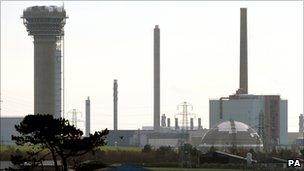NI state papers: Files Reveal Secret Dumping of Radioactive Waste
- Published

Previously confidential government files from 1983, released on Friday in Belfast, confirm the secret dumping of radioactive waste in Belfast and Londonderry in the early 1980s.
They also show that the issue of radioactive discharges, from the Windscale nuclear plant in Cumbria, generated concern among Northern Ireland Office (NIO) officials, 30 years ago.
The issue first surfaced in a briefing note for a visit by an NIO minister to Down District Council in November 1983.
In a note to officials, Miss A E V Kingsmill warned that "the question of radioactive pollution from Windscale and the associated cancer scare has raised a great deal of concern in certain coastal areas of the district, for example at Kilclief (County Down)."
At the same time, the Northern Ireland Assembly, set up by Northern Ireland Secretary Jim Prior to advance devolution, had discussed the issue of nuclear waste being dumped into the Irish Sea from Windscale. It had called upon the government to carry out an urgent survey into the levels of radioactivity on the coastline.
In response to these concerns, officials prepared a briefing note for NIO minister Adam Butler that sought to reassure the public.
It was dated 6 December 1983 and emphasised that regular monitoring of the coastline, as well as of seaweed and fish, had been carried out since 1977, following the Windscale Inquiry of that year.
These surveys showed that the radioactivity of the seaweed samples generally fell within a typical West Europe background level.
It went on: "The fish samples are taken from catches landed at Ardglass and Portavogie. The activity of the samples can be above normal background levels depending on the season and the area of the catch."
However, even these enhanced levels were well within the limits recommended by the International Commission on Radiological Protection.
The files show that in the Republic of Ireland, samples of seaweed were collected at Carlingford, Skerries, Dunmore and Rosslare and sent to the United Kingdom's Fisheries Research Laboratory for analysis.
The files said: "The concentrations reported to date (in the south) are considered to be of no radiological significance."
The NIO's interest in Sellafield coincided with a Yorkshire Television programme in November 1983 about a possible increase in the incidence of cancer in the communities surrounding the reprocessing plant.
In response to the impact of this programme in Northern Ireland, a memo in the file, dated 5 December 1982, revealed that solid radioactive waste had been buried at two local authority disposal sites during the period 1977-1982.
These were at Duncrue Street in north Belfast and at Culmore Point, outside Derry.
At Duncrue Street, the memo noted "a number of controlled burials of hospital/university waste of short half-life, together with small amounts of industrial waste were arranged."
The total activity disposed of was approximately 180 millicuries, of which the bulk comprised radioactive iodine with a half-life of less than two months.
At Culmore Point, two consignments of hospital waste had been disposed of by controlled burial; the total activity amounted to 170 microcuries.
The file noted that a number of hospitals, fertiliser plants and both of Northern Ireland universities had been authorised to dispose of radioactive waste by controlled burials at these sites.
- Published13 April 2000
- Published24 March 2000
- Published18 February 2000